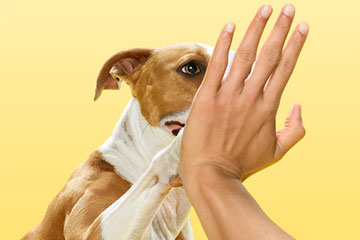
Katie Larkin met her first pit bull during college in the 1980s, when a friend brought home a small, muscular terrier with short fur and a big, square head. "He was adorable," Larkin recalls of Kilroy. "But anytime I walked him, people would cross the street."
That reaction is familiar to many owners of pit bulls, whose aggressive reputation and association with dogfighting have made them one of the least adopted and most euthanized breeds in the U.S., according to shelter operators. It isn't even legal to adopt or own a pit (unless it's a guide dog) in Miami or Denver, which are among the more than 300 municipalities that ban the dogs. So unloved are pit bulls--a term that refers to several terrier breeds with shared lineage--that they are routinely the most common dog in shelters nationwide.
Those daunting statistics led Larkin in 2010 to found Angel City Pit Bulls, a Los Angeles organization that works to increase pit adoption. The group is part of a loose network of pit lovers across the country who are trying to rehabilitate the reputation of America's most reviled dog. Through social media, the power of celebrity--actress Jessica Biel tweets weekly pictures of her pit with the hashtag #TuesdaysWithTina--and outreach efforts at decidedly gentle settings like schools and nursing homes, these advocates are making the case that pit bulls are no more dangerous than any other furry friend.
Media coverage and the tallies of dog violence based on them say otherwise, including a compilation of news reports by DogsBite.org a dog bite victims' organization, which found that pits were responsible for 52 of the 88 U.S. deaths from dog attacks from 2006 to 2008. Yet in controlled studies, pits have never been identified as "disproportionately dangerous," according to a 2012 American Veterinary Medical Association paper that advised against banning the breed.
One reason for the discrepancy is that people are bad at identifying a dog's breed, and the stigma surrounding certain breeds can play a role. A peer-reviewed study in the American Journal of Sociological Research in March asked vets, shelter workers and other animal professionals to identify the dominant breed of various mutts based on video images. Their performance was poor. The Centers for Disease Control acknowledged this inexact science in 1998, when it stopped categorizing dog bites by breed on the grounds that "there is currently no accurate way to identify the number of dogs of a particular breed, and consequently no measure to determine which breeds are more likely to bite or kill."
The focus on breed can obscure another crucial arbiter of a dog's behavior--its owner. "There are a few predictors that will create a problem dog," says Jane Hoffman, president of the Mayor's Alliance for NYC's Animals, a coalition of animal-rescue groups and shelters. Among them: "If they're kept in the yard, don't have interaction with people or other dogs and aren't neutered." In other words, a dog's lineage matters less than how it is conditioned. "But the popular imagination always has to have some kind of demon dog," she says.
The goal of Larkin and other advocates is to expand the popular perception of pits from a single behavioral type--the demon dog--to include what they used to be known as: America's family dog.
Family-Friendly Roots
